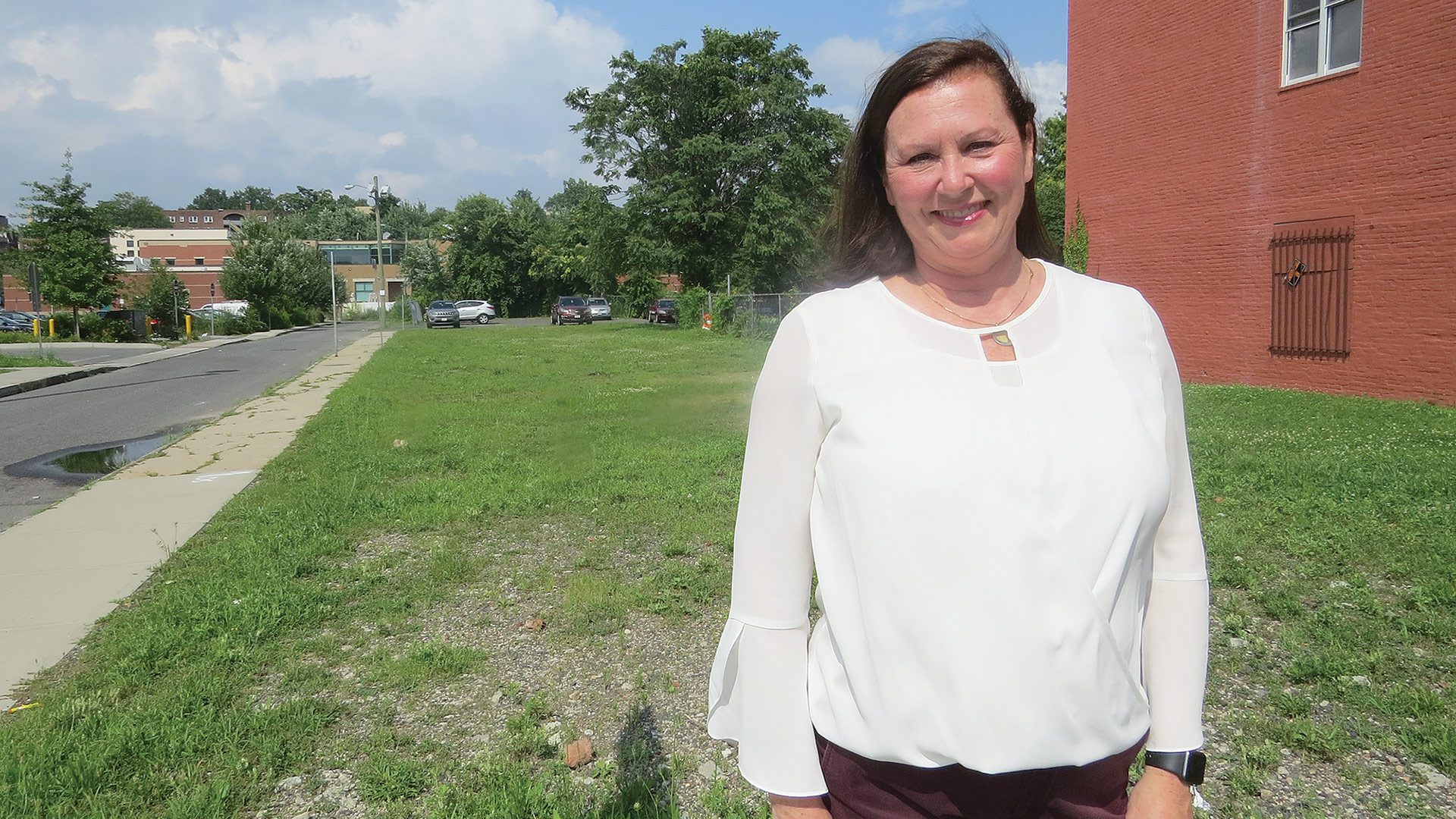Earning and Learning

Dawn DiStefano, seen here with a group of Square One kids, says early education isn’t a career for everyone, but those with the right mindset and heart for it will find robust opportunities there.
Dawn DiStefano says early education is “not a career path for the faint of heart,” or something to just settle on.
But for the right person, she added, it can be highly rewarding.
“You’ve got to have the interest and skills and tenacity and heart to want to work with young children. You can’t be, ‘there’s nothing else I want to do, so I’ll try my hand in childcare,’” said DiStefano, president and CEO of Square One, quickly adding that someone with those qualities she mentioned will find a field bursting with opportunity.
“If people don’t want to work in the early-education and childcare space, it prohibits others from going to work,” she said. “Businesses are hiring, and people want to go to work, but they need a place for their children to be.”
Recognizing challenges in the early-education space, the state established what’s known as the Early Education and Child Care Task Force earlier this year, focusing on the essential role childcare plays in driving the state’s economy and competitiveness — and, for that matter, the health and well-being of its families.
“Affordable, accessible, and quality childcare is a significant infrastructure needed in Massachusetts, and an imperative to drive the state’s economic competitiveness,” Secretary of Labor and Workforce Development Lauren Jones said when the program was announced. “I look forward to working with my colleagues across government and with business and community partners to build a strong pipeline of early childhood educators and also enhance the system to encourage our untapped talent to fully participate in our workforce.”
“If people don’t want to work in the early-education and childcare space, it prohibits others from going to work. Businesses are hiring, and people want to go to work, but they need a place for their children to be.”
The pipeline has been solid at Square One, DiStefano said.
“Why do people want to work here? It’s not like our kids are any easier than other kids; they’re all children. But a lot of it has to do with the culture and environment at Square One. We invest in you early on, whether as a young person, just starting out in your career, or as an older adult with a midlife change of heart.”
While entry-level wages aren’t the main draw in any early-education setting, she added, Square One lays out the long-term picture. “We say, ‘here’s the career pathway. Here’s what it looks like, and we’ll be flexible with your schedule, if you want to take advantage of free classes at HCC and STCC.’”
Indeed, in recent years, the state has been actively investing in early education in a number of ways, including free programs at its 15 community colleges through the Massachusetts Department of Early Education and Care’s (EEC) Career Pathways Grant.
One of those, the Family Childcare Institute at Springfield Technical Community College, is currently running June 3 through July 9.
“This is a three-course bundle that will help new family childcare providers get licensed and learn how to run a childcare program in their home,” said Nancy Ward, Career Pathways Grant and Activity director at STCC. “We see this as a great opportunity for anyone who wants to open their own home-based childcare center.”
Christopher Thuot, vice president of Academic Affairs at STCC, added that such programs reduce barriers to help people in the community obtain an education. “The flexibility of the program accommodates individuals with varying schedules and commitments.”
State of Urgency
Meanwhile, applications for the state’s Early Childhood Educators scholarship are now open for the 2024-25 academic year. This scholarship is available for educators who work at programs licensed and/or funded by the EEC, including center-based, family childcare, and out-of-school-time programs.
And for the first time, the scholarship is available for staff who work at residential programs licensed by the EEC. The application process has also been simplified, and eligible majors have been expanded to better support career pathways for out-of-school-time educators.
“We know that far too many parents find it difficult to return to the workforce because of the high cost of childcare, and providers are facing the difficult decision between continuing in the profession they love or leaving for a higher-paid career.”
“Our administration is fully committed to supporting and expanding the early-education and care workforce. When programs have high-quality educators, they can offer better care to even more families,” Gov. Maura Healey said. “I know these important changes to the Early Childhood Educators scholarship will strengthen our supports for our hardworking afterschool educators and residential program staff, positively reinforcing a pipeline of high-quality early-education professionals.”
More than 500 scholarships were awarded for the 2023-24 academic year, an increase over the number awarded in the previous year. As of this year, the scholarship now covers additional majors, including human services, psychology, social work, elementary education, and special education.
“Our Early Childhood Educators scholarship supports educators and program leaders to advance their careers and ensure that our youngest learners are receiving the highest-quality education they deserve, setting them up for school and lifetime success,” Secretary of Education Patrick Tutwiler said. “I am grateful to our departments of Early Education and Care and Higher Education for their partnership and collaboration with early educators and community partners in making this scholarship even better, reflecting current higher-education pathways and expanding access in a simpler way.”
As noted earlier, the state has also established the Early Education and Child Care Task Force, recognizing the role childcare plays in driving the state’s economy and competitiveness — at a time when keeping residents and businesses from fleeing the Commonwealth, for reasons ranging from housing to cost of living, has become a significant concern.
“If you support folks, get them into the industry by paying them to learn, they’ll probably be more motivated to work for you full-time as an employee. And in our field, we are desperate to strengthen our workforce.”
“We know that far too many parents find it difficult to return to the workforce because of the high cost of childcare, and providers are facing the difficult decision between continuing in the profession they love or leaving for a higher-paid career,” Healey said. “Childcare is central to the success of our entire state — for affordability, education, workforce, equity, and our economic potential — and together we are taking important steps toward solutions.”
The Early Education and Child Care Task Force will engage with industry and business leaders, organized labor, health-services stakeholders, housing and planning experts, working parents and caregivers, and childcare providers and experts in order to craft recommendations aligned with the following five policy objectives:
• Surveying practices of other states in reducing costs, increasing capacity, and improving quality of childcare providers and making recommendations for how such practices could be adopted in Massachusetts;
• Assessing how better coordination among state agencies could support families in accessing childcare that meets their needs, including through technology improvements;
• Identifying resources for building capacity and increasing affordability in the state’s mixed-delivery childcare system, including from the federal government, the philanthropic community, and employers, which may include exploring incentives for employers to assist employees with child care;
• Identifying strategies to recruit, train, upskill, and retain members of the childcare workforce, including by expanding apprenticeship initiatives, higher-education programs, and training opportunities; and
• Reviewing existing assets to identify potential locations to establish center-based care.
“Childcare and early education are critical enablers for economic growth in Massachusetts,” Secretary of Economic Development Yvonne Hao said. “Through this task force, the administration will take a whole-of-government approach to ensure that the state has equitable childcare solutions to meet the needs of the workforce and economy, making Massachusetts the best place to raise a family, grow a business, and succeed in a fulfilling career.”
Thinking Outside the Box
DiStefano said she’s excited about a new, state-level push for an apprenticeship model for early education, similar to buiding trades like electrical, plumbing, carpentry, and HVAC, where young people are paid to gain experience as they learn.
“People need to work and earn a living. People do not want to go to a four-year college and come out with debt for a $17-an-hour job. And we know our industry doesn’t start off very strong with hourly wage,” she noted. “So you’ve got to be creative. I’m excited about this potential apprenticeship model, where you’re paid to learn.
“It’s a balance, much like in other trades, like plumbing or electricity, where you go to work and you’re also training in the classroom to strengthen your formal education. And you’re getting paid to do all that, whether it’s by the business community or the philanthropic community or in a government-supported way.
“If you support folks, get them into the industry by paying them to learn, they’ll probably be more motivated to work for you full-time as an employee,” she went on. “And in our field, we are desperate to strengthen our workforce.”
What seems to be emerging, DiStefano said, is a realization that statewide investments in early education will pay off exponentially in the broader economy, allowing parents to work and businesses to retain talent.
And whether it’s through expanded scholarships, free community-college programs, or innovative apprenticeship initiatives, the impact is the same: more people able to work, learn, and generate income while doing it.
“There’s no better selling point,” she told BusinessWest. “The field of childcare and early learning is looking at the model of the trades and saying, ‘maybe we can do that.’ So I’m excited about the changes in our workforce development. This is an exciting moment to be in this field.”










